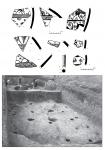Summary (English)
The central part of ash hill 10 was explored during the season of 2009. Two dwellings, several household pits, remnants of one altar and 26 sacrificial animals were explored within the trench measured 210 m2.
Northern dwelling measured 9.2 × 6 m and up to 2 m deep. Its construction was supplemented with an additional pit 0.3 m deep that was placed in the separate household niche in the southern wall. 35 postholes for the wooden frame were detected alongside the walls. The entrance was traced as a step dugout in the northern wall. The eastern corner of the house is distinguished by numerous small postholes up to 2 cm in diameter. Fragments of several human skulls and numerous animal bones that can be considered as sacrificial ones were deposited within this object. The majority of the collected artefacts consist of handmade pottery. Besides that, a carved horn psalia, bronze arrowheads and adornments, iron pins, needles and knives could be mentioned. Most of the amphorae fragments as well as painted pottery dated by the mid. 6th c. BC.
The southern dwelling was explored not to a full extent. However, the researchers trace its measures 9.95 × 8.25 m and 1.8 m deep. The wooden construction of the hut was fixed in the 26 postholes up to 20 cm in diameter. The lower part of the dwelling was filled with mixed layers of black soil and clay. Its upper part was filled with a layer of ash 1 m thick. The most distinguished finds from this complex are the horn psalia, Greek table wares, bronze arrowheads, pins and a bracelet. All the artefacts are dated by the late 7th – early 6th c. BC.
Remnants of the altar were traced not far from the Northern dwelling. It was the layer of burned soil on which researchers discovered broken parts of the clay construction with a smooth surface.
More than 20 thousand animal bones were collected during excavation on the ash hill 10. According to analyses, the majority of the sacrificial bones belonged to dogs, pigs and small cattle.
- Shelekhan Oleksandr - Institute of Archaeology, National Academy of Sciences of Ukraine
Director
- Iryna Shramko - V.N. Karazin Kharkiv National University
- Stanislav Zadnikov - V.N. Karazin Kharkiv National University
Team
- Vladislav Bondarenko - V.N. Karazin Kharkiv National University, Museum of Archeology and Ethnography of Slobidska Ukraine
- Kseniia Bondar - Taras Shevchenko National University of Kyiv
Research Body
- ДП «Слобідська археологічна служба» ОАСУ Інституту археології НАН України / State enterprise «Slobidska archeological service» of the state enterprise «Protection of the archeological survey of Ukraine» of the Institute of Archeology of the National Academy of Sciences of Ukraine
- Музей археології і етнографії Слобідської України Харківського національного університету ім. В.Н. Каразіна / Museum of archeology and ethnography of Slobidska Ukraine, V. N. Karazin Kharkiv National University






![Download [PDF]](/excavation/skins/fasti/images/results/download_sml.png)